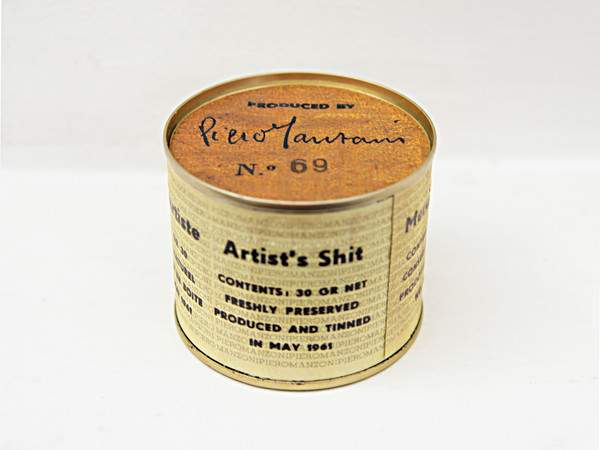From Manzoni to Fontana, an exhibition in Rome on art in Milan between the 1960s and 1970s
From September 28 to November 20 in Rome, at theAuditorium Conciliazione, a major exhibition will be open to the public dedicated to the extraordinary season of art in Milan between the 1960s and 1970s, The Fabulous Sixties and Seventies in Milan, a moment of splendid fervor that gave rise to a true revolution of visions and forms of expression in which the work of art was radically transformed in its theoretical framework and physical nature.
The exhibition is promoted by the Fondazione Terzo Pilastro - Internazionale, chaired by Prof. Avv. Emmanuele F. M. Emanuele, and is realized by Poema in collaboration with the Auditorium Conciliazione. On display are more than thirty works by the major protagonists of art in Milan in those years, carefully reread in its complexity and in its different trends and declinations. The exhibition is divided into four sections, in an overview that aims to highlight the co-presences, divergences, admixtures and commonalities of outlooks of a period of great and happy creativity. The intention, in fact, is to give life to a dialogue between Rome and Milan, in a tribute and an exchange of solicitations between the two great poles of art in Italy during the years of Italy’s economic boom and rebirth.
The first section Arte, Materia e Spazio Verso Lo Zero will thus present works by Vincenzo Agnetti, Getulio Alviani, Rodolfo Aricò, Agostino Bonalumi, Enrico Castellani, Lucio Fontana, Paolo Scheggi, and Michele Zaza. The second section Nouveau Réalisme between Italy and France will instead include Arman, Piero Manzoni, Mimmo Rotella, Daniel Spoerri. The third section Nuclearism and Abstractions will then feature Roberto Crippa, Sergio Dangelo, Gianni Dova, Emilio Scanavino. The fourth section In the Worlds of New Communication will be collected finally Valerio Adami, Enrico Baj, Lucio del Pezzo, Bruno Di Bello, Ugo Nespolo, Fabrizio Plessi, Sergio Sarri, Emilio Tadini.
The exhibition thus traces the most innovative phases of the avant-garde in Milan between the 1960s and 1970s, starting with the experiences of opening up to a new space and new territories, of an abstraction that opens up to theenvironment and the space of life, to frequently go beyond painting and sculpture understood in the traditional sense, in a vision that often makes use of the new materials of contemporary reality or their cancellation in a mental dimension that culminates in the new conceptual outcomes.
The aniconic experiences, the dialogue with science, architecture and design, the object withdrawal from the new industrial world, the dialogue and dialectics with the mass media and with the new paradigmatic solicitations of the collective universe of “popular” cultures will thus give rise to a fascinating mosaic rich in insights and new possibilities for reflection.
Says Prof. Avv. Emmanuele F. M. Emanuele, President of the Fondazione Terzo Pilastro: "I am very pleased to return to propose an exhibition on Italian art of the 1960s and 1970s, after the one held last year in Rome at the Galleria Monogramma in Via Margutta and dedicated to the Scuola di Piazza del Popolo. Milan in those years was the hub of the international Avant-Garde in which movements and trends, from Spatialism to Nuclear Art, were taking shape. Not surprisingly, it was characterized by a strong, so to speak, more ’scientist’ animation, in which the artists, who proclaimed its primacy through a close comparison with the European Avant-gardes, were connoted by a very subjective vision of their creativity: I am thinking of Enrico Baj, Roberto Crippa, Gianni Dova, Ugo Nespolo. Moreover, while the artists of the Roman area-Mario Schifano, Franco Angeli, Tano Festa, Renato Mambor and others-appeared more in dialogue with American Pop Art (perhaps also due to the Capital’s special relationship with the United States, fueled by the cinema boom that made Cinecittà ’Hollywood on the Tiber’), Milan was more in tune with the European artistic context, particularly with France, Belgium and England. The experimentation and innovation of which the artists active in the Milanese square at that time made themselves the bearers represented a cultural turning point that was not only Italian and indelibly marked an epoch, compared to which even today I cannot think of another that can stand comparison."
A Gangemi editore catalog will be published on the occasion of the exhibition, with texts by Prof. Emmanuele Emanuele, Enrico Lombardi, Lorenzo Canova, Alberto Dambruoso and Guglielmo Gigliotti.
Pictured: Piero Manzoni, Merda d’artista.
 |
| From Manzoni to Fontana, an exhibition in Rome on art in Milan between the 1960s and 1970s |
Warning: the translation into English of the original Italian article was created using automatic tools. We undertake to review all articles, but we do not guarantee the total absence of inaccuracies in the translation due to the program. You can find the original by clicking on the ITA button. If you find any mistake,please contact us.





























